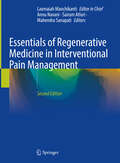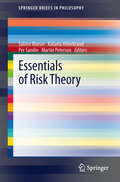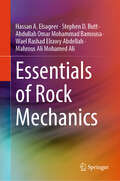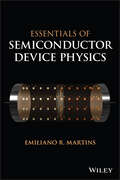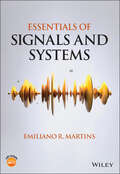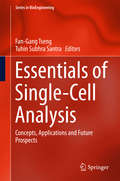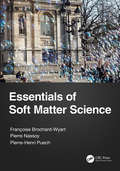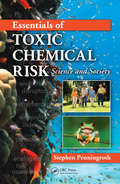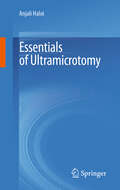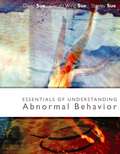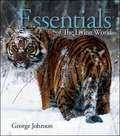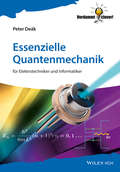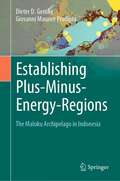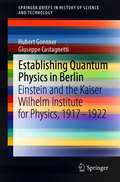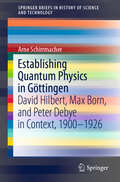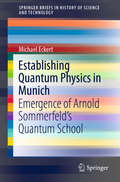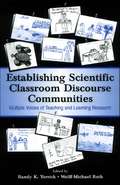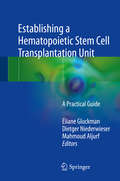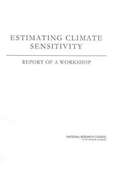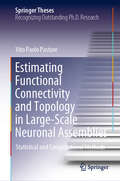- Table View
- List View
Essentials of Regenerative Medicine in Interventional Pain Management
by Laxmaiah ManchikantiRegenerative medicine is an emerging and integral part of interventional pain management and meets definitions of interventional pain management and interventional techniques. Interventional techniques are defined as minimally invasive procedures including, percutaneous precision needle placement, with placement of drugs in targeted areas or ablation of targeted nerves; and some surgical techniques such as laser or endoscopic diskectomy, intrathecal infusion pumps, and spinal cord stimulators, for the diagnosis and management of chronic, persistent, or intractable pain. On the same token, interventional pain management is defined as the discipline of medicine devoted to the diagnosis and treatment of pain related disorders principally with the application of interventional techniques in managing subacute, chronic, persistent, and intractable pain, independently or in conjunction with other modalities of treatment.This new edition brings a wide array of information for interventional pain physicians and other physicians practicing regenerative medicine with its applications in managing chronic pain and other disorders. The structure of the book begins with an introduction of the subject, followed by sections on historical context, pathophysiology, applicability of regenerative medicine with its evidence base, anatomy, technical aspects, complications, and precautions for each topic when available and applicable. From across the globe, leading experts in their respective fields contributed chapters on specific topics to present a cogent and integrative understanding of the field of regenerative medicine as applicable for interventional pain physicians. This comprehensive text achieves its goal of providing an evidence-based approach to application of principles of regenerative medicine in managing chronic pain of spinal, neurological, and musculoskeletal origins.
Essentials of Risk Theory
by Martin Peterson Sabine Roeser Per Sandin Rafaela HillerbrandRisk has become one of the main topics in fields as diverse as engineering, medicine and economics, and it is also studied by social scientists, psychologists and legal scholars. This Springer Essentials version offers an overview of the in-depth handbook and highlights some of the main points covered in the Handbook of Risk Theory. The topic of risk also leads to more fundamental questions such as: What is risk? What can decision theory contribute to the analysis of risk? What does the human perception of risk mean for society? How should we judge whether a risk is morally acceptable or not? Over the last couple of decades questions like these have attracted interest from philosophers and other scholars into risk theory. This brief offers the essentials of the handbook provides for an overview into key topics in a major new field of research and addresses a wide range of topics, ranging from decision theory, risk perception to ethics and social implications of risk. It aims to promote communication and information among all those who are interested in theoretical issues concerning risk and uncertainty. The Essentials of Risk Theory brings together internationally leading philosophers and scholars from other disciplines who work on risk theory. The contributions are accessibly written and highly relevant to issues that are studied by risk scholars. The Essentials of Risk Theory will be a helpful starting point for all risk scholars who are interested in broadening and deepening their current perspectives.
Essentials of Rock Mechanics
by Hassan A. Elsageer Stephen D. Butt Abdullah Omar Mohammad Bamousa Wael Rashad Abdellah Mahrous Ali AliThis book extensively covers rock mechanics and engineering, playing a vital role in mining, geological, and civil applications. It explores the stability, failure, and behavior of rock masses, offering control and prediction methods. Fundamental concepts, stress and strain analyses, failure theories, and rock characteristics are addressed, essential for safety in mining and construction. Applications like geological hazard assessment, slope stability, and foundation design demonstrate its significance in civil and geological engineering. The book's structured approach includes an overview in Chapter 1, stress analyses in Chapter 2, and plane strain analyses in Chapter 3. Subsequent chapters delve into rock behavior, failure theories, and specific properties. Practical aspects, such as designing underground openings, are covered in later chapters. The incorporation of numerous solved tutorials enhances its value for students and educators seeking a comprehensive understanding of these pivotal topics.
Essentials of Science Classroom Assessment
by Xiufeng LiuA concise science assessment text that helps K–12 teachers master the effective science assessment methods that lead to improved student learning Presenting both traditional and innovative assessment methods integral to science teaching and learning, Essentials of Science Classroom Assessment shows teachers the connection between effective science assessment and improved student learning. The text uses a competence-based approach consistent with the National Science Education Standards to help teachers master assessment skills, apply them to science classroom instruction, and evaluate their impact on student learning. Key Features and BenefitsProvides practical examples from both elementary and secondary science classrooms to demonstrate how to design a wide variety of traditional and innovative assessment methodsPresents case scenarios in each chapter that help teachers reflect on the assessment issues they will encounter in their own classrooms Includes end-of-chapter checklists and practice questions that allow readers to check their mastery of assessment skills before moving on, as well as annotated bibliographies that direct them to additional readings on topics of interest
Essentials of Semiconductor Device Physics
by Emiliano MartinsESSENTIALS OF SEMICONDUCTOR DEVICE PHYSICS An introductory semiconductor device physics textbook that is accessible to readers without a background in statistical physics The subject of this book is the physics of semiconductor devices, which is an important topic in engineering and physics because it forms the background for electronic and optoelectronic devices, including solar cells. The author aims to provide students and teachers with a concise text that focuses on semiconductor devices and covers the necessary background in statistical physics. This text introduces the key prerequisite knowledge in a simple, clear, and friendly manner. It distills the key concepts of semiconductor devices down to their essentials, enabling students to master this key subject in engineering, physics, and materials. The subject matter treated in this book is directly connected to the physics of p-n junctions and solar cells, which has become a topic of intense interest in the last decade. Sample topics covered within the text include: Chemical potential, Fermi level, Fermi-Dirac distribution, drift current and diffusion current. The physics of semiconductors, band theory and intuitive derivations of the concentration of charge carriers. The p-n junction, with qualitative analysis preceding the mathematical descriptions. A derivation of the current vs voltage relation in p-n junctions (Shockley equation). Important applications of p-n junctions, including solar cells The two main types of transistors: Bipolar Junction Transistors (BJT) and Metal Oxide Semiconductor Field Effect Transistors (MOSFET) For students and instructors, it may be used as a primary textbook for an introductory semiconductor device physics course and is suitable for a course of approximately 30-50 hours. Scientists studying and researching semiconductor devices in general, and solar cells in particular, will also benefit from the clear and intuitive explanations found in this book.
Essentials of Signals and Systems
by Emiliano R. MartinsNovel approach to the theory of signals and systems in an introductory, accessible textbook Signals and Systems have the reputation of being a difficult subject. Essentials of Signals and Systems is a standalone textbook aiming to change this reputation with a novel approach to this subject, teaching the essential concepts of signals and systems in a clear, friendly, intuitive, and accessible way. The overall vision of the book is that traditional approaches to signals and systems are unnecessarily convoluted, and that students’ learning experiences are much improved by making a clear connection between the theory of representation of signal and systems, and the theory of representation of vectors and matrices in linear algebra. The author begins by reviewing the theory of representation in linear algebra, emphasizing that vectors are represented by different coordinates when the basis is changed, and that the basis of eigenvectors is special because it diagonalizes the operator. Thus, in each step of the theory of representation of signals and systems, the author shows the analogous step in linear algebra. With such an approach, students can easily understand that signals are analogous to vectors, that systems are analogous to matrices, and that Fourier transforms are a change to the basis that diagonalizes LTI operators. The text emphasizes the key concepts in the analysis of linear and time invariant systems, demonstrating both the algebraic and physical meaning of Fourier transforms. The text carefully connects the most important transforms (Fourier series, Discrete Time Fourier Transform, Discrete Fourier Transforms, Laplace and z-transforms), emphasizing their relationships and motivations. The continuous and discrete time domains are neatly connected, and the students are shown step-by-step how to use the fft function, using simple examples. Incorporating learning objectives and problems, and supported with simple Matlab codes to illustrate concepts, the text presents to students the foundations to allow the reader to pursue more advanced topics in later courses. Developed from lecture notes already tested with more than 600 students over six years, Essentials of Signals and Systems covers sample topics such as: Basic concepts of linear algebra that are pertinent to signals and systems. Theory of representation of signals, with an emphasis on the notion of Fourier transforms as a change of basis, and on their physical meaning. Theory of representation of linear and time invariant systems, emphasizing the role of Fourier transforms as a change to the basis of eigenvectors, and the physical meaning of the impulse and frequency responses. What signals and systems have to do with phasors and impedances, and the basics of filter design. The Laplace transform as an extension of Fourier transforms. Discrete signals and systems, the sampling theorem, the Discrete Time Fourier Transform (DTFT), the Discrete Fourier Transform (DFT), and how to use the fast fourier transform (fft). The z-transform as an extension of the Discrete Time Fourier Transform. Essentials of Signals and Systems is an immensely helpful textbook on the subject for undergraduate students of electrical and computer engineering. The information contained within is also pertinent to those in physics and related fields involved in the understanding of signals and system processing, including those working on related practical applications.
Essentials of Single-Cell Analysis
by Fan-Gang Tseng Tuhin Subhra SantraThis book provides an overview of single-cellisolation, separation, injection,lysis and dynamics analysis as well as a study of their heterogeneity usingdifferent miniaturized devices. As an important part of single-cell analysis, differenttechniques including electroporation,microinjection, optical trapping, optoporation, rapid electrokinetic patterningand optoelectronictweezers are described in detail. It presents different fluidicsystems (e. g. continuous micro/nano-fluidic devices, microfluidic cytometry)and their integration with sensor technology, optical and hydrodynamic stretchers etc. ,and demonstrates the applications of single-cell analysis in systems biology,proteomics, genomics, epigenomics, cancer transcriptomics, metabolomics,biomedicine and drug delivery systems. It also discusses the future challengesfor single-cell analysis, including the advantages and limitations. This book is enjoyable reading material whileat the same time providing essential information to scientists in academia andprofessionals in industry working on different aspects of single-cellanalysis. Dr. Fan-Gang Tseng is a Distinguished Professor ofEngineering and System Science atthe National Tsing Hua University, Taiwan. Dr. Tuhin Subhra Santra is a Research Associate at the California Nano Systems Institute, University of California at Los Angeles, USA.
Essentials of Soft Matter Science
by Francoise Brochard-Wyart Pierre Nassoy Pierre-Henri PuechAuthored by world-leading physicists, this introductory textbook explores the basic principles of polymers, colloids, liquid crystals, wetting, and foams. It is a practical ‘toolbox’ for readers to acquire basic knowledge in the field and facilitate further reading and advanced courses. Undergraduate students in physics, biology, and the medical sciences will learn the basics of soft matter physics, in addition to scaling approaches in the spirit of the Nobel prize laureate in physics in 1991, Pierre-Gilles de Gennes, the inventor of soft matter physics and close collaborator to author Françoise Brochard-Wyart. Features: Accessible and compact approach Contains exercises to enhance understanding All chapters are followed by a short 1-2 page "insert chapter" which serve as illustrations with concrete examples from everyday life (e.g. the Paris Metro, a zebrafish, a gecko, duck feathers etc.)
Essentials of Tissue and Cells Banking
by George Galea Marc Turner Sharon ZahraIt has been 10 years since the first edition of ‘Essentials of Tissue Banking’ has been published. There is still relatively little published on the technical and scientific principles on routine tissue and cell banking based on scientific principles. The 1st edition was very successful and, after a 10 year gap, there is a need of an update and an expansion of the book’s remit.The format of the book follows that of the previous edition- split into 5 sections. Management of donors and the banking of common tissues and cells; Principles of storage and processing of tissues and cells; Ensuring the safety of the products by testing the donor, the tissues and the environment, supported by a quality system and an IT infrastructure- all working within the constraints of current regulatory and ethical environments.This edition however provides a significant update. Many the chapters have been completely rewritten by different experts. Like the 1st edition, they were given a free hand in the way they wrote their chapter, with a guideline that they had to be concise, clear and up to date. The authors were also asked to provide the scientific and technical basis that provides the rationale of the processes they describe. Also, the scope of the book has been somewhat extended. In view of the fact that many cellular therapies are now routinely practiced, 2 new chapters have been added: one on the banking of haematopoietic stem cells and one on human embryonic stem cells. They have been deliberately chosen to illustrate the extreme spectrum of cellular therapies from one of the simplest to one of the most complex. The intention of the book has remained the same: to cover and update banking of current practices in essential tissue and cell banking. It is therefore hoped that by keeping the book as concise and up to date as possible, it will find a place on the shelves of many tissue establishments.
Essentials of Toxic Chemical Risk: Science and Society
by Stephen PenningrothThis volume provides a basic introduction to toxicology within a framework of chemical risk to ecosystems and to human health and forms the basis of a new approach to teaching toxicology from a broad, interdisciplinary perspective. It presents concepts from chemistry, ecology, physiology, and other disciplines as needed within the context of toxicology. These include chemical equilibrium, energy, and nutrient flows through ecosystems. It also introduces concepts specific to toxicology, such as risk as a composite of toxicity and exposure, and provides case studies of risk management to illustrate the ways in which laboratory results are used to manage chemical risk to human health and the environment.
Essentials of Ultramicrotomy
by Anjali HaloiThis book commences with an introduction to the fundamental principles of light and electron microscopy, laying the groundwork for readers to grasp the significance of ultramicrotomy within these fields. It addresses every aspect of ultramicrotomy, including its history, instrumentation, procedural intricacies, as well as guidelines for maintenance and troubleshooting. A number of images and illustrations have been included to depict every step of the ultramicrotomy procedure to facilitate deeper understanding of the subject. It also talks about different techniques that can be employed for enhancing the quality and precision of the microscopy results. This book is a resource for researchers, faculty members, students, microtomists and microscopists working on sample preparation and analysis through transmission electron microscopy.
Essentials of Understanding Abnormal Behavior
by David Sue Herald Wing Sue Stanley SueAn elaborate text on why people exhibit abnormal behaviours, how they express their disturbances, and how such behaviours can be prevented, diagnosed and treated.
Essentials of Water Systems Design in the Oil, Gas, and Chemical Processing Industries
by Malcolm Clark Bill Boyd Alireza BahadoriEssentials of Water Systems Design in the Oil, Gas and Chemical Processing Industries provides valuable insight for decision makers by outlining key technical considerations and requirements of four critical systems in industrial processing plants--water treatment systems, raw water and plant water systems, cooling water distribution and return systems, and fire water distribution and storage facilities. The authors identify the key technical issues and minimum requirements related to the process design and selection of various water supply systems used in the oil, gas, and chemical processing industries. This book is an ideal, multidisciplinary work for mechanical engineers, environmental scientists, and oil and gas process engineers.
Essentials of the Living World
by George Johnson Joel BerghJohnson’s Essentials of The Living World text is written with an emphasis on the "how” and “why” of Biology, focusing on concepts rather than terminology and technical information. Utilizing a clear, straightforward writing style, the text helps students apply scientific principles to daily life. The 7th edition includes contributions and pedagogy from new coauthor, Dr. Joel Bergh.
Essentials of the Living World 4th Edition
by George B. JohnsonEssentials of The Living World is often considered a student favorite. George Johnson has written this non-majors textbook from the ground up to be an engaging and accessible learning tool with an emphasis on "how things work and why things happen the way they do". Essentials of The Living World focuses on concepts rather than terminology and technical information, and features a straightforward, clear writing style and a wide variety of media assets to enhance the content of the textbook.
Essenzielle Quantenmechanik: für Elektrotechniker und Informatiker
by Peter DeákDer Autor zeigt an Beispielen aus der Festkörperelektronik und der Quanteninformationstechnologie, welche Rolle quantenmechanische Konzepte in der modernen Energie-, Kommunikations- und Informationstechnik spielen.
Establishing Plus-Minus-Energy-Regions: The Maluku Archipelago in Indonesia
by Dieter D. Genske Giovanni Maurice PradiptaThis book explains and illustrates how Indonesia as the largest and most populous country in Southeast Asia can become independent of fossil fuels by both reducing its energy needs and using renewable resources. A study presented in this work focuses on the Maluku Archipelago in eastern Indonesia with Ambon as its capital. Conventional energy is brought to the islands over long distances by partly simple means as boats, ships and aircrafts. This unsustainable situation calls for a decentralized renewable energy supply strategy. Based on the research presented in this book, it is clear that the archipelago has the potential to become a so-called plus-minus region. Plus-minus regions are regions that produce more renewable energy than they need and capture more CO2 than they emit. The authors are convinced that the presented strategy illustrated on the Maluku Archipelago can be transferred to other regions of the world and that only by developing plus-minus regions the international 2°C climate goal can be achieved. The model region thus serves as proof that the plus-minus target can also be achieved in emerging countries with limited financial resources.
Establishing Quantum Physics in Berlin: Einstein and the Kaiser Wilhelm Institute for Physics, 1917–1922 (SpringerBriefs in History of Science and Technology)
by Hubert Goenner Giuseppe CastagnettiThis book explores Albert Einstein’s move to Berlin and the establishment of the Kaiser Wilhelm Institute for Physics under his directorship. Einstein’s call to Berlin was supported by a group of prominent physicists, including Fritz Haber, Walter Nernst, Max Planck, Heinrich Rubens, Emil Warburg, and the young astronomer Erwin Freundlich, in the expectation that Einstein and the institute would take the lead in advancing quantum physics in its early phase. Examining both the abortive attempt and the successful opening of the institute in 1917, it also discusses in detail the institute’s activities up to 1922, when Einstein relinquished the directorship, as well as his reasons for stepping down. The final chapter evaluates the institute’s activities and its role in the advancement of physics. In the end, the institute only partially fulfilled the expectations of its promoters because of the waning interest in quantum physics on the part of its director and board, and also because of Einstein’s refusal to exert scientific leadership. The book is part of a series of publications in the SpringerBriefs series on the early network of quantum physics.
Establishing Quantum Physics in Göttingen: David Hilbert, Max Born, and Peter Debye in Context, 1900-1926 (SpringerBriefs in History of Science and Technology)
by Arne SchirrmacherQuantum mechanics – the grandiose theory that describes nature down to the submicroscopic level – was first formulated in Göttingen in 1925. How did this come about and why is it that Göttingen became the pre-eminent location for a revolution in physics? This book is the first to investigate the wide range of factors that were pivotal for quantum physics to be established in Göttingen. These include the process of generational change of physics professors, the hopes of mathematicians seeking new fields of research, and a new understanding of the interplay of experiment, theory and philosophy.
Establishing Quantum Physics in Munich: Emergence of Arnold Sommerfeld’s Quantum School (SpringerBriefs in History of Science and Technology)
by Michael EckertThis book traces the history of Arnold Sommerfeld’s famous “nursery of theoretical physics” at the University of Munich and demonstrates the centrality of developing personal and institutional networks for the emergence of quantum theory. Sommerfeld, originally a mathematician with little interest in theoretical physics, was a somewhat unlikely choice for a chair of theoretical physics when he was appointed in 1906. However, he quickly reoriented his research focus towards physics, forstering a keen interest in experimental research. Possibly even more important for the development of quantum theory in the coming years was his exceptional talent as a charismatic teacher and prolific networker, which turned Munich into a central node in the fast-growing network of quantum physicists in the 1920s. It is no coincidence that the two most talented “child prodigies” of 1920s quantum physics, Wolfgang Pauli and Werner Heisenberg, were his students, nor that by the end of the decade about a dozen of Sommerfeld’s former disciples held chairs in theoretical physics. The book is directed at historians of science and physics, as well as all those interested in the history of science diplomacy and networking.
Establishing Scientific Classroom Discourse Communities: Multiple Voices of Teaching and Learning Research
by Wolff-Michael Roth Randy YerrickEstablishing Scientific Classroom Discourse Communities: Multiple Voices of Teaching and Learning Research is designed to encourage discussion of issues surrounding the reform of classroom science discourse among teachers, teacher educators, and researchers. The contributors--some of the top educational researchers, linguists, and science educators in the world--represent a variety of perspectives pertaining to teaching, assessment, research, learning, and reform. As a whole the book explores the variety, complexity, and interconnectivity of issues associated with changing classroom learning communities and transforming science classroom discourse to be more representative of the discourse of scientific communities. The intent is to expand debate among educators regarding what constitutes exemplary scientific speaking, thinking, and acting. This book is unparalleled in discussing current reform issues from sociolinguistic and sociocultural perspectives. The need for a revised perspective on enduring science teaching and learning issues is established and a theoretical framework and methodology for interpreting the critique of classroom and science discourses is presented. To model and scaffold this ongoing debate, each chapter is followed by a "metalogue" in which the chapter authors and volume editors critique the issues traversed in the chapter by opening up the neatly argued issues. These "metalogues" challenge, extend, and deepen the arguments made. Central questions addressed include: *Why is a sociolinguistic interpretation essential in examining science education reform? *What are key similarities and differences between classroom and scientific communities? *How can the utility of common knowledge and existing classroom discourse be balanced toward alternative outcomes? *What curricular issues are associated with transforming classroom talk? *What other perspectives can assist in creating multiple access to science through redefining classroom discourse? Whether this volume improves readers' science teaching, assists their research, or helps them to better prepare tomorrow's science teachers, the goal is to engage them in considering the challenges faced by educators as they navigate the seas of reform and strive to improve science education for all.
Establishing a Hematopoietic Stem Cell Transplantation Unit
by Éliane Gluckman Dietger Niederwieser Mahmoud AljurfThis text aims to provide simplified practical guidelines to start a hematopoietic stem cell transplantation unit which could be implemented in most centers and countries worldwide. The book also provides guidelines for existing transplantation units to upgrade their practice and implement new policies and procedures, in addition to developing therapies according to latest international standards and regulations. The book covers a wide range of practical implementation tools including HSCT program team structure, building inpatient and outpatient HSCT units, requisite laboratory support for transplantation program, practical aspects of stem cell collection and processing, HSCT program quality management, education and training, and data management. The book also addresses cost effectiveness and recommendations for establishing transplantation program in countries with limited resources. Written by group of internationally established experts in their corresponding hematopoietic stem cell transplantation fields, with contributions from many leaders of hematopoietic stem cell transplantation organizations, Establishing a Hematopoietic Stem Cell Transplantation Unit: A Practical Guide is an essential, practical resource for all members of the multidisciplinary hematopoietic stem cell transplantation team.
Estimating Climate Sensitivity: Report Of A Workshop
by Board on Atmospheric Sciences Climate“Climate sensitivity” is a term used to characterize the response of the climate system to an imposed forcing, and is most commonly used to mean the equilibrium global mean surface temperature change that occurs in response to a doubling of atmospheric carbon dioxide concentration. The purpose of this workshop was to explore current capabilities and limitations in quantifying climate sensitivity and consider whether there are alternative approaches for characterizing climate response that might better suit the information needs of policy makers.
Estimating Combined Loads of Diffuse and Point-Source Pollutants Into the Borkena River, Ethiopia (IHE Delft PhD Thesis Series)
by Eskinder Zinabu BelachewThis book is an initial attempt to estimate the loads of heavy metal and nutrient loads into an industrial effluent receiving rivers of a typical industrializing catchment. It shows the effects and impacts of diffuse and point sources of these loads into the rivers, and illuminate management, capacity and policy gaps of riverine water and sediment monitoring in the sub-Saharan countries perspective from Ethiopia. The study was done in semi-arid catchments of Kombolcha city with industrialising urban and peri-urban areas in north-central Ethiopia. The Leyole and Worka rivers, which receives industrial effluent and wash-off from the catchments’ areas, were monitored for two years. This book contribute to our understanding on applicable methods to quantify loads of diffuse and point sources in data poor areas, and the most important contribution is to address the gaps in in controlling emission changes and. The results of this book contribute to the theory of river protection and understanding of water quality management of sub-Saharan African tropical rivers and sediments and provides policy options for improvement in rivers water quality of the sub-Saharan countries. In bridging this gap, this book proposed a model to estimate the total loads of nitrogen and phosphorus from a catchment.
Estimating Functional Connectivity and Topology in Large-Scale Neuronal Assemblies: Statistical and Computational Methods (Springer Theses)
by Vito Paolo PastoreThis book describes a set of novel statistical algorithms designed to infer functional connectivity of large-scale neural assemblies. The algorithms are developed with the aim of maximizing computational accuracy and efficiency, while faithfully reconstructing both the inhibitory and excitatory functional links. The book reports on statistical methods to compute the most significant functional connectivity graph, and shows how to use graph theory to extract the topological features of the computed network. A particular feature is that the methods used and extended at the purpose of this work are reported in a fairly completed, yet concise manner, together with the necessary mathematical fundamentals and explanations to understand their application. Furthermore, all these methods have been embedded in the user-friendly open source software named SpiCoDyn, which is also introduced here. All in all, this book provides researchers and graduate students in bioengineering, neurophysiology and computer science, with a set of simplified and reduced models for studying functional connectivity in in silico biological neuronal networks, thus overcoming the complexity of brain circuits.
